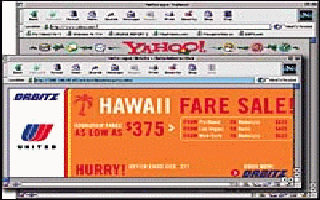The tides are turning in Internet advertising. According to experts, advertisers are becoming more aggressive in making sure their ads are seen and the Web sites on which they appear are less concerned about how annoying or intrusive those ads might be. ”The marketplace has really changed,” said Richard Cleveland, vice president of marketing for Newport-based technology providers Bluestreak. Cleveland, whose company partners with advertising agencies to offer a range of Internet technologies for designing advertisements, said advertisers are taking more liberties with the types of ads they are using. “Advertisers have a little more leverage as far as getting these ads onto sites,” he said, citing such technologies as pop-under ads, which are the ads that open second windows upon clicking onto a homepage without the users’ prompt. Other instances of this sort of unsolicited advertising can include ads where a graphic will ski, crawl or zoom across a user’s screen on the same page, and block part of the text he or she could be reading. While many in the industry have said they have found the persistent and unexpected advertisements menacing, others see this sort of advertising as overdue for the Internet. Jon Duffy, president of Providence advertising agency Duffy & Shanley, said interactive advertising is a win-win situation. “It’s an accepted part of the deal now,” he said. “It’s tough to go to a major site where you don’t have a pop-up window.” “It’s a tremendous way of advertising on the Internet. You go from the flat banner ad to something that asks the consumer to interact with it more,” he said. “At the very least it forces the user to interact by clicking on the box to close it.” Duffy also said we should think of the Internet as we think of other commercial mediums rather than our own private exploration. “You don’t usually throw something at your television when an ad comes on,” he said. “And in a newspaper if you don’t want to see an ad you turn the page.” Cleveland said there is a reason why these interstitial pop-up ads are so ubiquitous. “People hate those 8 by 10 cameras that you see all those ads for, but the reason they keep marketing them is the marketer says they’re getting a good response,” he said. Orbitz, the Chicago-based Internet travel service company, has also utilized this method of online advertising. With pop-ups showing up on over 100 Internet sites from daily newspapers to search engines such as Yahoo!, the company recently reported that the amount of site traffic and transactions have reached record levels. “Our strategy has pretty much been to get out there everywhere and anywhere,” said Orbitz Director of e-Marketing Geoff Silvers. “The e-marketing has definitely exceeded our expectations in terms of making sales.” Silvers said that because the campaign seems to be everywhere, Orbitz even has a complaints area for users who are fed up with pop-under ads from the company. “Of course there’s an occasional user that writes us (to complain), but in relation to the amount of ads we have out there, it’s a relatively small amount. We do have a specific account set up where people who complain can sign up for a service that will disable pop-unders though,” Silvers said. Although there are new ways of communicating messages, Internet advertising itself has not increased this year, but rather held steady. According to the Interactive Advertising Bureau’s Internet Ad Revenue Report, which is conducted independently by PricewaterhouseCooper’s New Media Group, Internet advertising in the U.S. held steady at $1.792 billion in the third quarter of 2001. The first nine months of 2001 revenue stands at $5.55 billion, compared to $6.06 billion for the first three quarters of 2000.
TOPICS
- Subscribe
- Free Newsletters
- Current Issue
- Subscriber Only
- All5QBusiness BestsellersBusiness WomenCover StoryDining OutEditorialsEverybody's BusinessExecutive PollFeaturedFocusFranchiseeFresh DesignHealth MattersHot TopicIt's PersonalListsNew ConstructionOne Last ThingOp-EdPrint EditionSomething NewSpotlightTrendingWhat’s HappeningWho Owns the Block?Who's on the Board?
- News
- Health Care
- Education
- Real Estate
- Lists
- Events
- More
- Submit
- Sponsored Content
- Advertising Opportunities
- Login
- Subscribe Today
Sign in
Welcome! Log into your account
Forgot your password? Get help
Privacy Policy
Password recovery
Recover your password
A password will be e-mailed to you.
SUBSCRIBE TO
PBN's All Access Subscription
PBN subscribers get ahead with unlimited access to PBN news, information, and insights from our editorial team, research and data, webinars and much more.
SIGN UP FOR
PBN's Daily Newsletters
Get PBN's top stories and breaking news every day in your email inbox.
OUR MISSION
Helping you succeed in business since 1986.
© Providence Business News. All Rights Reserved.













